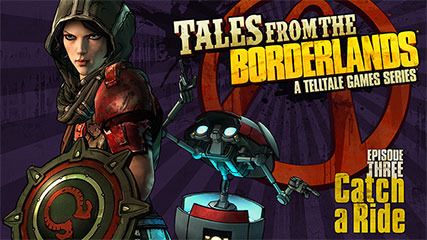
- Format: PC (version reviewed), OS X, iOS, PS3, PS4, Xbox 360, Xbox One, Vita
- Unleashed: Out Now
- Publisher: Telltale Games
- Developer: Telltale Games
- Players: 1
- Site: https://www.telltalegames.com/talesfromtheborderlands/
- Game code provided by the publisher
Whilst it may not quite be hitting the standards of Valve time, Tales from the Borderlands Episode 3 seemed to take its sweet time getting here. A full three lunar cycles after we left our heroes in complete peril, we finally get to see how our concluding decision plays out in Catch a Ride. Obviously from here we’re in the prickly tundra of spoiler territory for Episodes One and Two, so if you haven’t played those yet, go back now!
Who you chose to trust at the end of Atlas Mugged heavily influences the opener for Episode 3, even though the two different branches quickly meet up on the same path again. For what it’s worth, we preferred the version where we trusted Jack for sheer spectacle and badassness, whilst Fiona’s plan lacks the punchiness and goes the slightly more subtle route. Still, it’s always nice to know that your decisions can drastically change the immediate outcome (even though the paths merge again within five minutes), something we feel has lacked slightly in other Telltale adventures.
Whichever route you go on, it leads to the introduction of a new big bad character who ends up causing you grief at several opportunities throughout Catch a Ride’s two hour play time. She’s a completely new character to the series, although seems a little copy-and-paste from The Big Book of Generic Small Screen Baddies. At least another psycho boss would have maintained the series of enemies who are as predictable as a bee in a washing machine.

“Sweep us up in your arms, you jet-propelled steel prince”
From here things are a little more familiar again, with control shifting between Rhys and Fiona as they recap their story thus far to their shotgun-wielding masked captor. There’s a definite lull in the middle this time around. Whilst the dialogue and interaction between characters is still top notch, our heroes don’t seem to cover a lot of ground. You end up in another hidden research facility that has that ‘apocalypse grime’ look interior, which has become very familiar after the first two episodes. There also doesn’t seem to be much more use for Tales from the Borderlands’ slightly quirkier features, like Rhys’ robot eye and Fiona’s deep pockets.
In fact, at one stage we felt quite frustrated with the state of Fiona’s inventory. We won’t give much away, but remember that single bullet you started with and had the options to save or use? We enjoyed not knowing whether we were squandering ammo or taking the most important shot in the story. Well, limited ammunition no longer becomes an issue as you’re handed a crate of it, kind of taking away from some of the more interesting decisions the game could ask you to agonise over. Still, we won’t fret over it too much, as Telltale are generally good at stirring up difficult decisions out of anything; but it just seems like a wasted opportunity.

Is it just us or does this look distinctively Iron Man-y?
Another frustration that gives us the grumbles is the slightly broken save system. Perhaps autosaves are just taken for granted these days, but we would assume that after a loading screen the game would save there and allow you to return to that point after a break from playing. Turns out we were wrong to assume such a thing as we lost a good 20 minutes worth of progress. Unlike other games that allow you to play things slightly differently on a revisit, the majority of the dialogue offered on this forced replay was stuff that we had already heard. It had that feeling of one big unskippable cutscene, which seems like a real shame considering the general quality of the scenes in Tales from the Borderlands.
The concluding quarter of the episode is fairly action packed with a generous helping of that ever brilliant Borderlands humour (we love everything Loader Bot says). Having said that, it still doesn’t quite live up to the concluding moments of the first episode, with Zer0 Sum’s madcap murder rally proving to be a lot more exciting than anything we’ve seen from the game since. It’s not that this series peaked too early as such; it’s just that the bar has been set high. Whilst a few moments have come close, nothing has been as consistently entertaining as the finale of episode one (nor have episodes two and three lasted as long).

Do those arms look familiar to you?
One of our major points of praise from the first episode was how game-like certain sections were. There was a lot more interaction and some brilliantly used quick time events. Such things were reigned in a little for episode two, and episode three feels devoid of them in comparison. The two or three sections here are nothing like the loader bot brawl that made us giddy, or the adrenaline-spewing jumps between vehicles that had made us inch closer to our screens like it was a tense episode of our favourite show. This time around the offering was limp, and left us wanting a lot more hands-on elements.
Despite our selection of minor issues, Tales from the Borderlands is still keeping us entertained. We won’t lie, this has probably been our least favourite episode so far, but don’t take that entirely as a criticism. Every story needs a middle, and Catch a Ride serves up the perfect elements for that. We get a few new characters, a surprising cameo or two, and a new goal to focus on. Throw in a splutter of perfectly timed jokes at every turn and we’re confident you’ll find the fun in Tales from the Borderlands episode three. It’s just we’re now at a point where the story needs a badass psycho-sized bang to pick up the pace again.
]]>
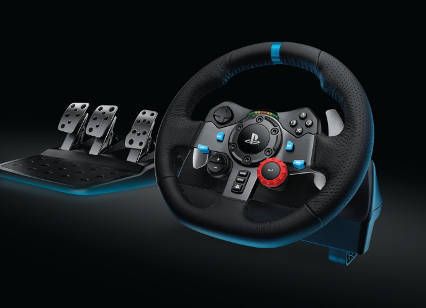
Any Google search will tell you that Logitech aren’t short of fans when it comes to their racing wheels, especially the much-loved G27. Such people are sure to rejoice with today’s unveiling of the Logitech G920 and G29 that finally bring the manufacturer’s Driving Force wheels to the Xbox One and PS4.
Both look and function in a largely similar way, with the PS3 and PS4 friendly G29 sporting the familiar PlayStation logo at its centre, whereas the G920 for Xbox One has Microsoft’s standardised button layout. There are a few differences, with the G29 sporting a few extra bells and whistles including LED gear shift indicator lights and a 24-point selection wheel, but the underlying build is very similar.
“Our fans have been asking for a PS4 wheel since launch of the system,” said Ujesh Desai, vice president and general manager of the Logitech gaming business. “For the past 18 months we have been working with Sony to deliver a fully-licensed racing wheel and I am excited to announce it today.”
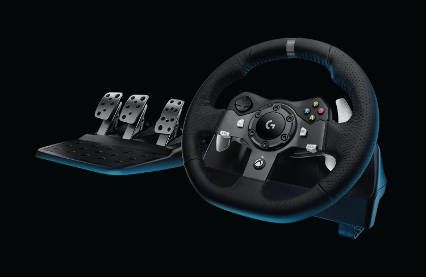
Of the G920, Ujesh also said, “The G920 is the wheel fans have been asking for on Xbox One. We built on our history and legacy of previous generation driving wheels to deliver on a truly immersive experience for Xbox One gamers. I personally can’t wait to get behind our new wheel to play Forza Motorsport 6.”
Both wheels feature realistic force feedback utilising a dual-motor system that brings to life every weight shift, brake fade or tyre slip felt on the track. They also include a responsive three-pedal floor unit with integrated throttle, brake and clutch pads. Everything features built in clamps and grips to keep it all squarely where you need it, so no worries if you drive like an excitable three year old in the front seat of daddy’s car.
If you’d like to get your hands on one of these wheels then you’ll need to ante up a fair chunk of your race day winnings, with an RRP of £299 attached to each wheel set. They do however both work with PC as well as your console of choice, so you will only need the one wheel to switch between your computer desk and console den.
The PlayStation flavoured G29 will be available in July, whereas Xbox users will have to wait a little longer for the G920 which is expected to screech out of the Logitech garage in October.
]]>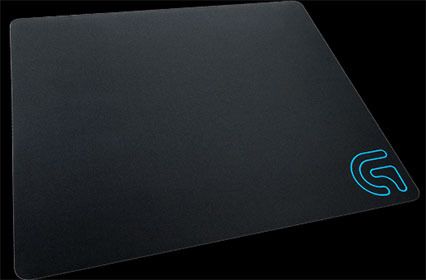
Hardware provided by the manufacturer
Remember back in the days when tables were made of nothing but splintered wood and mice rolled along on primitive balls? Uneven surfaces, less than satisfactory ball movement and the threat of dust and hair clogging up your precious ball port made a mouse mat essential. But we live in the future now! Desks are smoother than oiled silk and mice hover on magical lasers that translate physical wrist wiggles to screen movement that’s more precise than ever. Do we even need mouse mats anymore? Logitech argues that we do with the G240.
I wasn’t quite sure what to expect when the roll arrived in the post, with the hexagonal tube looking nothing like a mouse mat as I knew it. I’ll admit, it had been a while since I’d used a mouse mat let alone unpackaged one. Inspecting it closely, I noticed that one end invited me to “Touch Sample on Bottom”. After a childish giggle to myself, I ran my fingers across the base and was pleasantly surprised. It wasn’t the redundant desk-like or overly squishy foam padded surface I was half expecting, but instead it was smooth and cloth-like. I opened up the tube to find the mat itself rolled up, ready to unfurl on my desk.
At just 1mm in thickness, this seriously lightweight piece of mouse furniture is very portable and ideal if your computer desk away from home is less than desirable for mousing. Not only that, but as the profile is so low you’re not going to nudge it out of place by accident and upset the feng shui around your personal space. The grippy padding on the base also helps secure it in place, just as you’d expect from any good mouse mat.
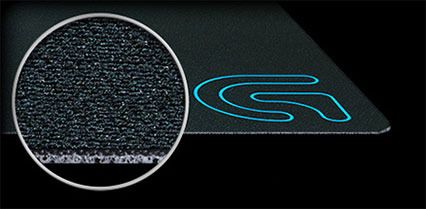
Here’s a millimetre of mouse mat up close. You’re welcome
Compared to using the mouse on a hardwood surface, the difference is immediately noticeable. Things feel a lot smoother, as you’d naturally expect, with none of the slightly gritty grindy sounds you get for dragging a mouse all over your work space. The immediate difference I noticed was a surprising amount of friction, but not in a jarring way. As I tend to prefer heavier mice with the DPI settings turned up, the increased friction translated as a slight improvement in precision. It’s barely noticeable, especially after you’ve used it for two minutes, but it’s still there. It might be an issue if you’re using a less sensitive mouse, especially for gaming, but it’s not something that will throw up major barriers or break down the walls to gaming utopia either way.
An interesting note on the back of the box states that the surface has been matched to Logitech G sensors, like those found in the G303, G502 and other recently released gaming mice from the manufacturer. With mice that feature Logitech’s surface tuning detection technology, we’re sure that the G240 mouse pad provides the optimum surface for the sensors. I’ll admit, I didn’t notice a dramatic change in performance when tuning my Logitech mice to the cloth surface, but they already agreed with my desk anyway. If you’ve experienced any kind of trouble before, this pad should remedy that.
As far as design is concerned, I must admit I’m a little disappointed. The mat is all black with the exception of the Logitech G logo in the bottom right corner. You could argue that a mouse pad doesn’t need any bling other than the rodent that scurries around on it, but the solid colour and logo combo feels a little corporate. Even a subtle design would have added a bit of variety.

As you can see, it’s reliably mat-like
The other issue that a black surface throws up is that it’s a total dirt magnet. As a relatively new beard owner, I’m only just discovering the joys of wiping loose whiskers from my desk on a daily basis. But my stray facial hair appears to form colonies on the silky smooth surface of the G240, regularly partying with bits of dust and small particles that I really hope are just leftover crumbs from lunch. Within a week the pad is already dusty and speckled with the daily detritus of computer based living.
This dirt issue isn’t exactly helped by the size of it. Despite being 34cm wide, I only really use the central 15cm, even in the most extreme cases of sweeping the cursor. That means there’s more than 50% of the width that remains mouse free during regular use. It has however left plenty of space to publically display how infrequently I dust my computer space. There’s oodles of room that makes it feel a little excessive, especially considering the range of hyper sensitive gaming mice Logitech have launched recently. Reducing the size by 20 to 30% would certainly make it a lot more practical.
So do you need the Logitech G240 mouse pad? It’s handy if you can’t trust yourself to keep a portion of your desk quarantined from clutter to ensure you mouse has ample space to roam around. Likewise, it performs all of the duties from a mouse mat you would expect (for example, there are no lumps in it) and it performs them well. If you’ve never experienced an issue with your plain old desk surface, then we’d file the G240 under the ‘nice to have’ category. It won’t make a huge difference to your mouse activity and will take up more space than you’d typically use. If however you’re after something to add to the clean aesthetics of your gaming space, then this all-black number nicely identifies your designated rodent roaming area. There’s nothing flashy about it, but it’s practical and provides you with an ideal surface and a clean look (with regular dusting) if you’ve been lacking one.
]]>
Game code provided by PR
Arguably, the best thing about pen and paper RPGs is the group of people you play with, closely followed by the fluid and dynamic nature of each game that builds as you go along. Whilst videogames have done a superb job of completely killing the social aspect of these games, they’ve done lots when it comes to mapping out your quest as you play it. Guild of Dungeoneering goes even further than most, allowing you to build and populate a dungeon for an AI hero to conquer.
The first thing that will hit you in the face like a +10 enchanted mace is the beautiful style the game flaunts. It seems so simple, with your dungeon starting off as a near-enough plain piece of graph paper. This is old school pen and paper RPG territory and a great throwback for any fans of pre-screen RPG adventures. Everything looks like it has been hastily scribbled with a pencil, from the characters to the dungeons and even the text, making it visually distinct to anything else out there. And the graphics aren’t the only refreshing part of the experience either.
At its core, Guild of Dungeoneering is a dungeon builder, but it’s unlike other games in this niche genre. Whereas most dungeon builders encourage you to lay traps to mash and smash curious heroes, this time you’re building a dungeon that encourages looting and plundering. You can place corridors, monsters and sweet, sweet loot, all of which helps to guide your plucky NPC hero through the dank halls and dimly lit rooms you’ve laid out. If you build a chamber and make it worth visiting by dropping a piece of loot at its centre, your hastily drawn character will happily trundle along to investigate, which can be to their peril if you’ve put down a particularly nasty monster too.
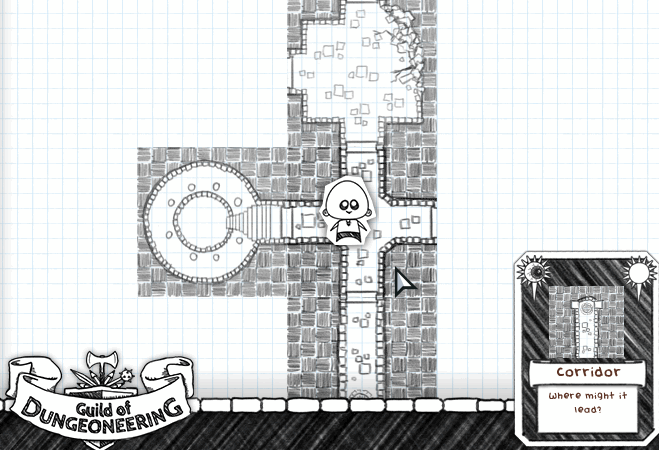
The game generally has two parts to each turn, the placement phase and the action phase. During placement you’re presented with a hand of five cards with either a dungeon part, creature or piece of loot printed on it. Drag and drop dungeon parts to expand the sprawling lair ahead of your adventurer, then put down loot and monsters to fill the areas. Your hero will automatically charge towards the best looking location, whether that’s a piece of loot or a lowly-looking piece of dungeon monster meat to swipe at. When a creature is encountered the battle mode begins.
Combat is played out with a very simple yet quite addictive card battling game. At the start of your turn you’re presented with three cards, each one with a different type of action. It might deal damage, block, counter or add a number of other little twists. The kicker is that you can see the action the enemy AI is going to make, challenging you to pick the best counter move to win the battle. It’s a fun system that makes you think a tad strategically instead of spamming attacks.
After your foe is toppled you’re rewarded with XP to boost your stats as well as an item of loot. Rather than a sword that gives your general attacks more heft or other usual buffs, equipment in Guild of Dungeoneering adds additional cards and abilities to your attack deck. So whereas your normal cards may only allow you to deal up to two damage, a sword may slip a card into your hand that allows you to deal three damage. Again, it’s a new take on loot and equipment that fits in with the pen and paper RPG feel brilliantly.
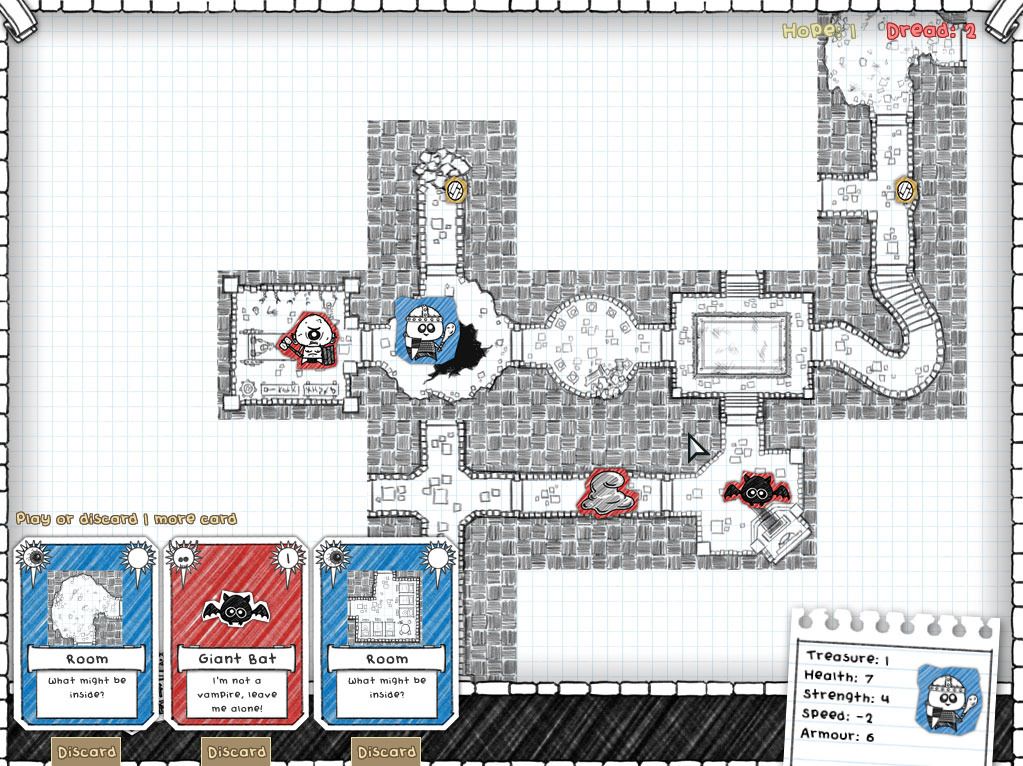
But it’s not just about having an aimless jolly around a dark dungeon. In the build that we played, our adventurer was tasked with striking down the dungeon boss. The only snag was that we didn’t have a route to him yet, meaning we had to sculpt a path and fill it with loot and monsters along the way, allowing us to suitably level up. It’s a great idea, but one that started to lead to a few frustrations along the way.
The main issue is that the cards you use to build the dungeon are drawn at random. This means that you can get nothing but dead ends and left turns, which is a huge pain when you need to grow your dungeon in the opposite direction to reach a pre-placed boss or treasure room. In the one level available to preview, the boss has a ten turn countdown timer before he gains an HP buff and becomes a little too powerful to strike down. Therefore, to beat him you can’t really fanny about building a winding, twisting dungeon of intrigue, but are better off building a straight corridor. This random layout mechanic adds a fun flavour to the format, but makes it a little maddening when you’re working towards a specific location.
Another feature that’s still under construction is the ability to build a guild. The full game will keep track of your progress, recording the gold and gear you bring back from your custom dungeons. This gold can in turn be used to upgrade your guild, which branches out and builds up in a similar way to the dungeons. A better guild attracts more dungeoneers to your doors, allowing you to acquire adventurers along the way who are a little more capable at hack and slash.
Even though it’s still in the early stages, Guild of Dungeoneering looks very promising. The demo scenario we played is great fun and could grow into an amazing turn-based game that’s unlike anything else we’ve played before. It’s obviously still in its early stages, but with a little more love and a few more scenarios built into it, this could be a real hit with near unlimited replay value due to completely randomised dungeons that you build. The card combat feels like it could do with a bit of fleshing out, but we’re sure that’s up in the air with the other development bits.
]]>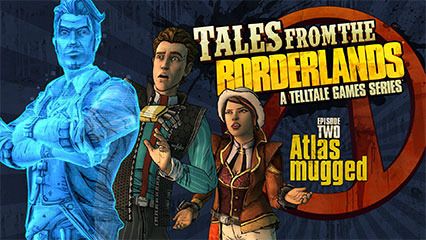
- Format: PC (version reviewed), OS X, iOS, PS3, PS4, Xbox 360, Xbox One, Vita
- Unleashed: Out Now
- Publisher: Telltale Games
- Developer: Telltale Games
- Players: 1
- Site: https://www.telltalegames.com/talesfromtheborderlands/
- Game code provided by the publisher
It’s been nearly four long and gruelling months since the release of Tales from the Borderlands episode one, which ended on an explosive cliffhanger with more bang than a slag charged Vladof rocket launcher. We were really fond of the first episode, Zer0 Sum, and its chaotic tour of bandit laden Pandora (seriously, read our review of Episode One if you haven’t already), so we had high hopes for part two, Atlas Mugged.
Without giving away any of the story, things pick up in the unusual place our heroes were left at the end of the last episode. The band starts off together, with Fiona, Rhys and their associates picking up the pieces and having a snout around the mini treasure trove in which they ended up. Gameplay is once again split between the perspectives of both main characters, meaning the story is free to hop about between locations as soon as the characters split up again. And it doesn’t take long for the chaos of Pandora to pick up and separate our gaggle of loveable rogues.

Activating boost mode without seat belts is ill advised
After a fairly slow (although quite funny) opening, an over the top action sequence kicks things into gear involving a monster, a car chase, and a severe case of orbital bombardment. It doesn’t amount to much more than the kind of quick time event we’ve come to expect from Telltale, but it certainly livens things up in the typical action movie on crack fashion we’ve come to expect from this always over-the-top series. From here, things don’t tend to slow down much thanks to a steady onslaught of clever dialogue, funny banter and wholesome violence. A few familiar faces pop up too, including everyone’s favourite wasteland wheeler dealer and yet another fan-favourite vault hunter.
Popping between locations both new and familiar, the episode concludes all too quickly at another climactic moment. The result of your final choice in the chapter is left a mystery, presumably until next time (please don’t be another four months away), and definitely has us dancing with excitement for the next instalment. It’s just that the build-up to the final moments of Atlas Mugged lacked the impact we felt in the series’ opening episode. Instead of a bullymong-sized punch sending us hurtling into a conundrum, it felt more like we were slowly wheeled into position by a trundling Claptrap. Not to say the story is bad by any means, but the action cuts out just as things get interesting. Still, always better to leave the audience wanting more (especially when it’s in a torturously teasing episodic format).
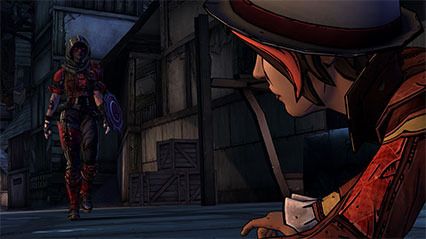
Now there’s a familiar throwing arm…
Whilst the story telling remains top notch as ever, the gameplay sections seemed to have taken a back seat this time around. Zer0 Sum had a variety of set pieces that carried a great sense of involvement, largely down to the use of Rhys’ ECHO eye and plenty of fun-loving violence. Atlas Mugged feels a little lacking in this department. Don’t get us wrong, it certainly has its moments, but they just feel very short-lived and not anywhere near as dramatic as the situations that cropped up last time around.
Another minor gripe we have is that our characters’ inventory pockets are starting to bulk up, but we’re not really sure what anything will do or how it will affect us later down the line. We keep coming across new items and cash that gets funnelled into the inventory panel which can be displayed on the screen at almost any time. The trouble is, you don’t get any sense of why you have these items, and no glimmer of satisfaction when it comes to using them. As such, we’re not sure whether it’s a wise idea to save the money that’s stacking up within Fiona’s purse, or just spend it during the couple of opportunities we’ve been given to splurge so far.
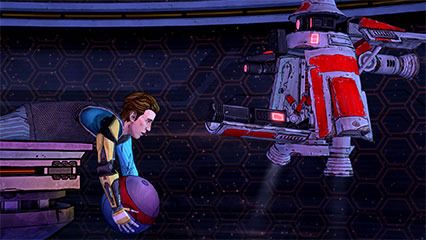
Just how will you talk yourself out of this situation?
Still the criticisms here are minor, as the experience is still classic Telltale. You can tell they pour love into every franchise they work on, and Borderlands is no exception. There are just enough nods to characters and recognisable locations to immerse you in the world, but plenty of new elements that make everything fresh and feel like a new game experience. It’s great to see a Pandora that’s not obscured by gun sights and explosions, but still shares that sense of manic craziness.
Overall, Tales from the Borderlands episode two, Atlas Mugged, is still highly enjoyable from start to finish. It’s a little slower, noticeably shorter and lacks a bit of oomph, but it’s still overflowing with that completely loveable Borderlands charm. Telltale have perfectly captured the feel for Gearbox’s smash hit world, immersing us amongst its colourful characters in a way we didn’t think was possible. We’re very much looking forward to part three of this Borderlands epic, but hope it picks up the pace a little bit, not to mention gives us content that feels a little fleshier. Atlas Mugged was over far too soon
]]>Hardware provided by the manufacturer
Someone at Logitech is seriously into starships at the moment. Not only does the G303 Daedalus Apex have a name like a space boat (much like the Hyperion Fury and Proteus Core before it), but the promotional video actual shows it flying through space. Although we must admit, the symmetrical design previously showcased in the G302 makes a pretty fine looking ship (better than any other peripheral basking in the glow of our monitors anyway). But space faring aesthetics aside, is it any good as a clicker?
The first thing you’ll probably notice is that it’s a dead ringer for the Daedalus Prime; indeed the outside and buttons are exactly the same. The key difference lies in the belly of this desk-straddling beast, as it features similar internals to the G502, including an advanced optical sensor that can tune itself to your gaming surface for optimal performance, precision and responsiveness. It might seem odd to dress up a new mouse in an old exterior, but that might be down to the pro gaming community. You know, the guys who are so good at games it earns them money and limited use of the word “athlete”.
You see, the G302 went down a treat with the eSports community, thanks to its simple yet elegant design that was as easy to use in the left hand as it was in the right. The only drawback was that it wasn’t particularly well endowed with techy bells and whistles, something that has been heavily addressed with the G303. As such, we’ve now got an ambidextrous mouse with guts that push it into the upper echelons of Logitech’s peripheral line-up.
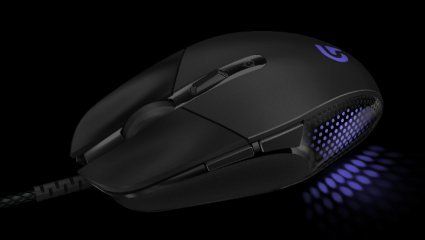
All six programmable buttons on display
Its DPI settings alone make it a fairly formidable beast, with a range of 200 DPI that stretches all the way up to 12,000. Of course, 12,000 DPI is way too high to be useful on 99% of monitors, but it’s always nice to know that the functionality is there, especially if you ever do get a 4K screen. We settled on a much more practical range that sits between 6,000 and 8,000, switchable using the toggle button that’s located behind the mouse wheel.
This is where our first major gripe arises with the G303. The DPI toggle button cycles through your DPI settings with each click, which is fine if you’re only shifting between the two; but if you have four different settings (as per the default), this can be quite fiddly. The button isn’t really located in a place that feels natural to click, requiring you to awkwardly curl back a finger in order to get anywhere close to clicking range. Add to this that the mouse has no visual representation of the setting you’re using, and you’re left with something that just isn’t practical for on-the-fly DPI shifting. To be fair, it isn’t a huge issue unless you like to flick over to a slow scope aim every once in a while, but it still feels like a poor design choice.
Other than that, the buttons are well placed, with two on the side and a middle mouse button in the scroll wheel alongside left and right buttons. And on the subject of the regular left and right clickers, they feel great! As with the G302 before it, the Daedalus Apex features the metal spring tensioning system that makes the primary buttons extra clicky. Or, to put it as the back of the box does, the buttons are “precisely positioned to reduce pre-travel and backlash, delivering optimal response and feel.” Like we said, extra clicky.
Another neat party trick the G303 has up its mouse hole is its light-up body. Whilst it comes sporting a fairly vanilla Logitech blue, you’re actually capable of changing the colour to one of 16.8 million others, allowing you to pick your favourite shade from the RGB spectrum. This light is projected from the ‘G’ logo on top as well as the spotted vent-like bits in the side. It also has a slightly eerie breathing effect to it that makes the light features of this mouse a little more interesting than the dazzling always-on effect used by most computer rodents. The lighting effects are also completely customisable using the ever impressive Logitech Gaming Software.
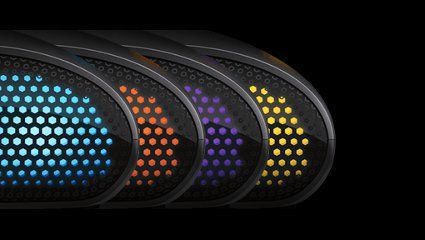
Not in the mood for blue today? Change it! LGS makes it easy
Although the mouse works completely fine straight out of the box, if you install the Logitech Gaming Software (or LGS as our lazy hands will call it from now on), you can get a lot more from it. The handy little program lets you do so much, including custom button bindings for specific games, fine-tuning your DPI settings, and all the cool light tinkering we talked about before. It also opens up toys like the surface tuning performance gadget – which allows the mouse to scan your gaming surface and adjust its setting to the optimum operating levels for your desk or mouse mat.
Whilst there’s nothing that really distinguishes the aesthetics of the Daedalus Apex over its predecessor (other than the customisable lighting), one minor detail is that the USB cable running from it is covered with a cord-like sheath rather than the plastic cover found on most mice. It’s a very minor difference, but it goes a little way to make this mouse feel like the premium version of the G302. Logitech’s record of durability and build quality is also continued in the G303 as it’s been tested to 20 million clicks without failure. Apparently. Not by us; we’re not maniacs.
Whilst it may not look like a mega mouse, the Daedalus Apex is definitely swinging above its weight class. A bit of a sabre-toothed tiger in sheep’s clothing, it’s perfect if you’re looking for an ambidextrous gaming mouse that’s packed with gadgets but isn’t overly flashy about it. As usual, the LGS makes almost every aspect easy to customise and configure, allowing you to get the most out of the mouse, even if it is a little light on the button front. It’s a direct upgrade from the G302 in every way.
]]>We were quite fond of Logitech’s G302 released last November, but noticed it was lacking a technical punch when compared to its bigger brethren, such as the G502 Proteus Core. Apparently it was common feedback posed to Logitech from the pro eSports community too, who liked the symmetrical design of the G302 but wanted a little more precision. Answering that concern today is the newly announced G303.
Named the Daedalus Apex (which doesn’t just sound like the name of a spaceship, but even becomes a spaceship in the promotional video above), the G303 is incredibly similar in design to its predecessor but features the advanced optical sensor of the G502. The sensor minimises mouse acceleration, giving users improved accuracy and precision as well as a huge DPI range that stretches from 200 all the way up to 12,000 with zero smoothing. It can also track movement at 300 inches per second, with the optical sensor tuning to whatever surface you’re swiping across.
“The community sent us a clear message that they wanted the lightweight, symmetrical design of our G302 combined with the amazing sensor in our G502,” said Ujesh Desai, vice president and general manager of the Logitech gaming business. “We took this feedback and built a mouse that was tuned and tested by pros to help ensure improved accuracy, comfort and performance. Thanks to you and this feedback, we’ve built an amazing product.”
If you liked the specs on the G502 but were held back by a crippling case of left-handedness, the G303 could be the gaming mouse for you. Expect to see it hit our shores this month with an RRP of £59.99.
]]>The classic swords and boards horseback general simulator returns next month with Total War: Attila. To whet our appetite and give us an idea of what’s going on, SEGA have sent over a trailer to showcase The Creative Assembly’s latest efforts.
None of it appears to be in-game god’s eye view or the mass battle scenes the series is known for, but the CG trailer gives us an idea about what to expect. The most obvious change to Attila over previous Total War titles is that settlements are now mobile hordes rather than brick and mortar cities.
The trailer sets the grim-tastic scene well, with the barren land getting harsher and harsher with every month, therefore forcing people onto the road in search of greener pastures. If you’d like something with a little more information and gameplay in it, take a look below to find the official feature spotlight.
Total War: Attila will be released next month on February 17 on PC and Mac. It’s not the only news we’ve had from the Total War house this month, as earlier it was also leaked that they were working on a Warhammer title for the series.
]]>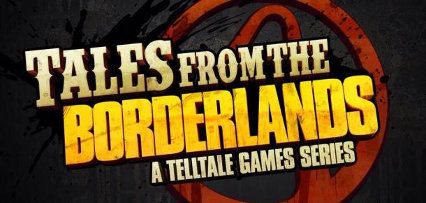
- Format: PC (version reviewed), OS X, iOS, PS3, PS4, Xbox 360, Xbox One, Vita
- Unleashed: Out Now
- Publisher: Telltale Games
- Developer: Telltale Games
- Players: 1
- Site: https://www.telltalegames.com/talesfromtheborderlands/
Pandora is an insane place, full of madness, murder and a way of life that teaches resilience through harsh conditions. Of course, in previous Borderlands offerings the player has been in the boots of one of these psychopaths, shooting through every problem and looting the corpses to sustain such a lifestyle. But what about the ordinary, less shooty stabby citizens of Pandora? It’s a concept that is beautifully explored in Tales from the Borderlands.
Telltale definitely have a distinctive style of their own when it comes to game design, something that gave us early concerns of a franchise mishmash with what is arguably Gearbox’s greatest success story. However, we’re happy to say that such concerns have been well and truly squelched like a psycho’s skull under a bullymong’s fist. Whilst the game is undoubtedly Telltale, they’ve done an incredible job of intertwining themselves with Borderlands DNA. As such it feels like a cracking story driven game in a vibrant world that has always slightly lacked in the narrative department.
So where does this adventure begin? Everything kicks off in the shoes of Rhys, a Hyperion employee who works aboard the corporation’s distinctive H-shaped space station. The grey corridors are traded in for the dusty plains of Pandora very soon though, as Rhys sets off on a get rich quick adventure with his pal from accounting in tow. As you’d expect, the game’s filled with lots of walking, talking, pointing and clicking, but with a few things that differentiate it from other games in the Telltale stables.

He can still be a friend if he’s unconscious, right?
One of these key differences is Rhys’ Echo Eye. A cross between x-ray vision, Google Glass and Wikipedia, this handy gadget allows you to scan characters and other highlighted bits of the environment, as well as hack things from a distance when the context sensitive action calls for it. The Echo Eye mostly boils down to extra fluff about the story and world, but the annotated trivia snippets are written so sharply that it usually raises a smile and is always worth a read. It also adds another layer to gameplay, even if it is just a new viewpoint from which to click and examine things.
About a quarter of the way through episode one, the game’s viewpoint shifts over to Fiona, a well-versed con artist and the game’s second playable character. Being a native of Pandora, she’s much more accustomed to the chaos and random stabbings that life on the planet brings with it. Whilst she lacks the bionic eye piece, she can (and regularly does) pick up cash. There’s only one opportunity to spend it in episode one, but if it’s anything like The Wolf Among Us then it might be handy to have a few bills tucked away for the next few episodes.
The world of Borderlands is quite a leap compared to Telltale’s previous story focussed games. Even though The Walking Dead and Wolf Among Us are filled with fantasy aspects, each is firmly rooted in a grim reality to which we can all relate. Tales from the Borderlands mixes this up with an unpredictable desert world that can lead you to strange places that usually turn out to be packed with danger. Well, danger with a liberal sprinkling of comic peril.

This guys wants to show you the rusty bit on his axe blade
Before now, the series’ humour has largely come from the odd snippet of dialogue and random bits of scenery, as well as over the top bosses and support characters. Yes it was funny in places, but those occasions were sandwiched between intense shooting sections and really had to be hunted down and savoured. However, in Tales from the Borderlands it’s laid on fairly thick and is very much more of what we’ve come to know and love. If you think about it things get a little dark in places, what with the generally murderous intent of psychos looking for the shiniest meat bicycle, but the art style and comic jibes keep the tone light.
The biggest thing that struck us is that Tales from the Borderlands is probably the most game-like of Telltale’s stable of interactive stories. Much of it is still in the vein of dialogue selection and QTEs, but gameplay seems a little more fleshed out this time around. You’re given more choices and more control over certain actions, making it a lot more engaging. As such, it’s also the most fun we’ve had in a Telltale game. That’s certainly not a criticism of The Walking Dead or The Wolf Among Us, it’s just that whilst those titles focussed more on grit and tension, Borderlands isn’t afraid to show its silly side every other minute.

Wait, we know that voice. It’s Nolan North again!
We don’t want to spoil the surprise by revealing our favourite bits here, so we won’t, but there was a section involving an orbital requisition and a group of bandits that left us smiling for minutes afterwards. Needless to say, the first episode is full of surprises and not quite like anything we’ve seen from the dev before.
Just like the end of the first chapter in any Telltale series, we’re left begging for more. Not just because the ending hit us with suspense, but because it feels like the interactive story formula has been refined and perfected into its best form yet. Cross that with a more story focussed Borderlands entry, and we think we might possibly have our favourite game from the Telltale crew yet. It’s well-written, packed with twists and turns, and incredibly playable despite being completely led by the hand through a narrative. At the end you’re given a snapshot of the choices you’ve made throughout the episode, giving you a bit of a recap about things that might affect future entries. Will they be huge changes? We can’t really say yet, but we definitely want to see what Tales from the Borderlands Episode Two has in store.
]]>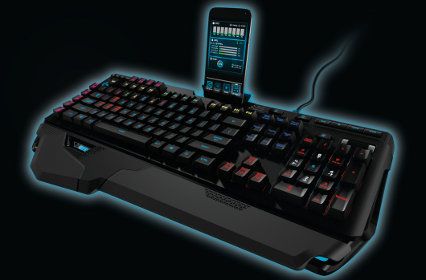
I don’t think I’ve ever excitedly beckoned someone through to the room to demonstrate what happens when a USB device is plugged in, but the Logitech G910 gaming keyboard had me do exactly that. Upon sliding the trusty universal connector into the back of my PC a rainbow of colour erupted across the keys, travelling in a sparkly wave from left to right with every bright colour I cared to remember. It’s a spectacle that blew me away before I had even poked at a key. But let’s be honest, a flashiness of an introduction is how you grade a peacock, not a gaming keyboard.
The G910, also known as the Orion Spark, is the latest piece of gaming input hardware to come out of the Logitech labs. The finely-tuned invisible spec headliner this time around is that it’s the world’s fastest mechanical gaming keyboard. The “exclusive new” Romer-G mechanical switches register your input up to 25 percent faster than other gaming keyboards, which the press release assures us will give you the edge in battle where every millisecond matters. Truth be told, it’s hard to notice this improved responsiveness. We suppose if you were to compare the Orion Spark to another keyboard under lab conditions, exerting an equal pressure on the keys of each simultaneously, then the G910 will edge out ahead of its competition. However, in the wild west of fastest finger first online gaming, this isn’t going to give you the magic bullet in a knife fight. But it is a really, really shiny knife.
You may be able to tell from the excitable introduction to this review, but the colour that comes from the keys adds a real wow factor to this keyboard. Everything starts off with the default Logitech blue that shines out of most of their other G-line gadgets. As soon as you’ve plugged this keyboard in, we really recommend you boot up the latest version of the Logitech Gaming Software. As well as offering the usual array of custom bindings and technical information, it also unlocks the aforementioned rainbow that lives within this desk straddling beast.
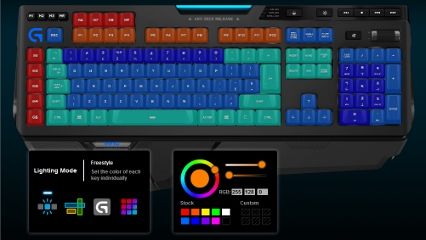
Colour code your gaming keys or just make things pretty – your call
With LGS loaded you can bring up a virtual representation of the G910 and paint every key individually with the click of a button. Whilst there are eight or so pre-defined colours, you can also create your own shades with a colour pallet that stretches to 16.8 million colours in the RGB spectrum. This allows you to mark specific button clusters or hot keys that are important for certain games, and colour code your keyboard to your own exact spec. By the end of it, if you don’t have what looks like a panel from Star Trek in front of you, you’ve done it wrong.
Whilst colouring keys is a purely cosmetic touch that probably won’t make you better at games, that doesn’t matter because the effect looks utterly brilliant. This isn’t a peripheral company that’s tried to make things impractically angular and Lamborghini-like for that sporty finish, but instead Logitech has created an accessible and customisable experience tailor made by you. It’s really well implemented too, with the colour contained to each key icon without an annoying amount of light seeping out underneath the keys to spoil the effect with an unwanted glow.
Anyway, getting back to the more functional aspects of the Orion Spark, we’re also happy to report it has nine programmable G-keys on board, all ready to be programmed with your favourite macros and keyboard shortcuts. It features a simple record function that allows you to press a button, record the key sequence, and then press another button to finish recording and instantly write the commands to a G-key. This allows you to do a variety of handy things in game, as well as a few lazy applications for when you’re going about your daily computer business (instantly recalling your email address with a button is really neat).

The fastest and the prettiest buttons in one fine slab of keyboard.
Aside from its super-colourful custom key array, the Orion Spark looks very dominating on your desk. At just over 50cm long it’s a little larger than an average keyboard, and at 1.5kg it feels heavier. It takes a bit more than a nudge to slide this thing about your desk, which is ideal for when you’re wrist deep in a game, but not so handy when you’re trying to clear space for a flight stick or notepad. It’s not a huge problem though, it just requires a little more effort than you will initially assume.
When it comes to the keys themselves, each one is specially shaped with a pitted groove that’s perfect for your fingers. They’ve been designed like this allegedly to help prevent mistyping, but each key cap also fits your fingertips like a treat, making it extremely comfortable for long gaming sessions, especially for those times when you’re just resting your middle finger on the W key. And if palm rests are you thing, the G910 comes with a couple for you to switch around and experiment with.
Its final party trick is a really nice smartphone dock that slides out at the back, allowing your second screen to stand vertically in your eyeline. While this can be quite handy for keeping an eye on the time or emails when in game, it’s actually designed to use with Logitech Arx Control app. This lets you do all sorts of things, like monitor your peripherals, hardware, media and can even display in-game information on your phone screen (although this feature isn’t widely supported at the moment).
All-in-all the Orion Spark G910 mechanical gaming is a real winner in our eyes. You may wince at the £159 RRP, but you’re getting a robust, comfortable and tech-packed gaming keyboard with all the bells and whistles attached. The customisable colours look incredible when tuned to your specifications, but features such as programmable macro keys and dedicated media controls make it perfect for commanding your rig. It’s as visually striking as it is technically impressive.
]]>

